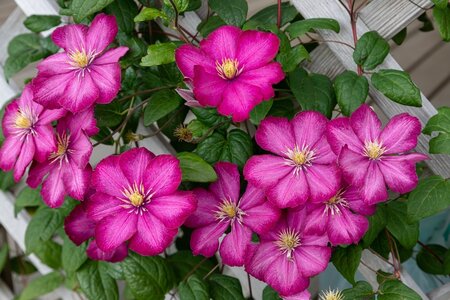
With so many different types of Clematis available, it’s possible to have one in flower almost all year round, covering walls, fences and trellises with their spectacular flowers. Here are a few tips to help you get the best out of your clematis.
Clematis groups and pruning
Clematis are divided into three groups based on their flowering time and their pruning requirements.
- Group 1: These are the winter and early spring flowering clematis, like Clematis cirrhosa, Clematis montana and Clematis armandii. They don’t need regular pruning but can be cut back immediately after flowering to keep them to size.
- Group 2: These clematises produce large flowers in early summer and often flower again in late summer. Prune in late winter or early spring, cutting down all stems by at least one-third to above a strong bud lower down the stem.
- Group 3: These clematises flower late summer and should be hard pruned in late winter or early spring. Cut all stems back to a strong set of buds around 15-45cm (6-18in) above ground level.
Tips on growing clematis
The best time to plant a clematis is in spring or early autumn when the soil is warm and moist. Clematis will cope with a range of soils, but they prefer a fertile, moist but well-drained soil, so dig in some compost or leafmould before planting. Although most clematis flower best in the sun, they like to have their roots in cool, moist soil. Putting slate or pebbles around the base of the plant helps to shade the roots and keep them cool.
When planting large-flowered clematis, plant them deeply so that the top of the rootball is around 7.5cm (3in) below soil level. This encourages the growth of new shoots and can also help the plant recover if it is affected by clematis wilt. To plant a clematis in pots, use a pot at least 45cm in diameter and fill it with a loam-based compost like John Innes no 2. Top dress with pebbles or gravel to keep the clematis roots cool.
Feed clematis in early spring with a high potash feed like rose fertiliser and mulch with compost after feeding. Feed container-grown plants monthly in spring and summer with a general-purpose liquid fertiliser.
Clematis wilt
Clematis wilt is a fungal disease that causes clematis leaves to shrivel and stems to wilt. However, wilting can also be caused by a lack of water or physical damage to the plant stems, so always check your plant’s environment first before diagnosing clematis wilt.
To treat clematis wilt, cut out and dispose of all affected material, disinfecting your tools afterwards. To reduce the risk of disease, plant clematis deeply, with space around them for good air circulation, and mulch annually – this reduces stress on the plant and makes it less prone to infection.
We have a fantastic range of clematis and other flowering climbers in our centre, so visit us today to find the one that’s perfect for your garden.







